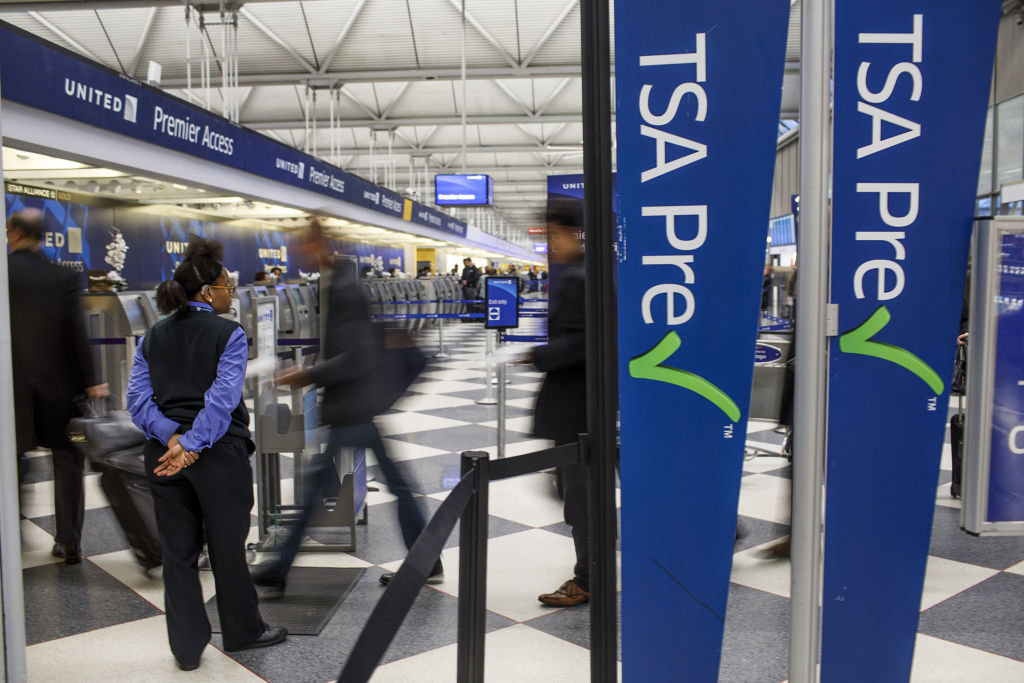Is TSA PreCheck Worth It? Pros, Cons and Costs
Long lines at the airport won't be a problem with TSA PreCheck.

One way to make travel more enjoyable is by cutting down on time spent in security lines. TSA PreCheck offers a way to move through airport screening more quickly and with fewer hassles.
The program is available at more than 200 airports across the U.S., and can make a noticeable difference during busy travel seasons when lines tend to grow longer. With a TSA PreCheck membership, you can drastically reduce the time spent waiting in the security line.
Even better, you won’t have to worry about removing your shoes, electronics, belt or jacket when being screened.
From just $107.88 $24.99 for Kiplinger Personal Finance
Become a smarter, better informed investor. Subscribe from just $107.88 $24.99, plus get up to 4 Special Issues

Sign up for Kiplinger’s Free Newsletters
Profit and prosper with the best of expert advice on investing, taxes, retirement, personal finance and more - straight to your e-mail.
Profit and prosper with the best of expert advice - straight to your e-mail.
It’s one small step that can help make the airport experience a little less stressful.
How much does TSA PreCheck cost?
A five-year TSA PreCheck membership costs about $78, and you can renew it for $59-$78, depending on what method you use to renew, up to six months before it expires.
It could cost you less, though, as select travel rewards credit cards cover some or all TSA PreCheck application fees through statement credit reimbursement.
Children 12 and under can join their parent or guardian in the TSA PreCheck lanes, but children 13 to 17 have to have the logo on their boarding pass, which happens by booking them on the same airline reservation with the PreCheck-enrolled parent or guardian.
Before you buy, keep in mind your application to be deemed a low-risk traveler includes an in-person enrollment portion.
Is TSA PreCheck worth the money?

With a $78 one-time fee, you pay about $15.50 per year over five years. What do you get for your money? Shorter wait times.
Up to 99% of PreCheck members wait less than 10 minutes at security, according to the TSA. Quick service via TSA PreCheck is also great for frequent fliers who plan to take multiple trips over the course of a year.
The lines at TSA PreCheck theoretically move faster than a traditional TSA security line because there are fewer security requirements with PreCheck.
For example, you don't have to take off your shoes or remove your laptop from your briefcase. In addition to saving time, PreCheck members are happy with those conveniences.
Note, though, that passengers 75 and older don't have to take off their shoes regardless of which line they're in.
Even if you're not rushing to catch your plane every time you travel, TSA PreCheck can come in especially handy at some of the busiest airports.
With the ability to breeze through the security line, you'll have more time to make your way to your gate — which in bigger airports, could be quite a trek from TSA.
Get TSA PreCheck benefits with Global Entry
If you often travel internationally, you may be better off applying for Global Entry. Run by the U.S. Customs and Border Protection, Global Entry costs $120 for a five-year membership and includes a TSA PreCheck benefit.
Plan on it taking from four-to-six months for your application to be processed. You can get updates and track the status of your application at check the Trusted Traveler Program website.
Additionally, it offers expedited customs processes when returning to the United States from out of the country.
Instead of dealing with customs interviews and paperwork, Global Entry members can complete their customs declaration at a Global Entry kiosk.
Is TSA PreCheck the same as Clear?
While going through airport security, you may also see signs for Clear. Clear is a company that uses biometrics for security clearances, and there are now many airports that use it.
PreCheck and Clear are different services. With Clear, you go through a different security line and, theoretically, get to skip the traditional security line and instead be escorted to the front of it.
Much like how Global Entry gives you TSA PreCheck, you can get both Clear and PreCheck. However, there's an extra cost associated with the Clear and PreCheck bundle.
For more details on the differences, see our article on Clear vs TSA PreCheck vs Global Entry.
Related Content
Profit and prosper with the best of Kiplinger's advice on investing, taxes, retirement, personal finance and much more. Delivered daily. Enter your email in the box and click Sign Me Up.

Erin pairs personal experience with research and is passionate about sharing personal finance advice with others. Previously, she was a freelancer focusing on the credit card side of finance, but has branched out since then to cover other aspects of personal finance. Erin is well-versed in traditional media with reporting, interviewing and research, as well as using graphic design and video and audio storytelling to share with her readers.
-
 I'm want to give my 3 grandkids $5K each for Christmas.
I'm want to give my 3 grandkids $5K each for Christmas.You're comfortably retired and want to give your grandkids a big Christmas check, but their parents are worried they might spend it all. We ask the pros for help.
-
 If You're Not Doing Roth Conversions, You Need to Read This
If You're Not Doing Roth Conversions, You Need to Read ThisRoth conversions and other Roth strategies can be complex, but don't dismiss these tax planning tools outright. They could really work for you and your heirs.
-
 Could Traditional Retirement Expectations Be Killing Us?
Could Traditional Retirement Expectations Be Killing Us?A retirement psychologist makes the case: A fulfilling retirement begins with a blueprint for living, rather than simply the accumulation of a large nest egg.
-
 My Teen Crashed His Car and Now Our Insurance Has Tripled. What Now?
My Teen Crashed His Car and Now Our Insurance Has Tripled. What Now?Dealing with the costly aftermath of a teen car accident is stressful. Here are your options for navigating it.
-
 My First $1 Million: Retired In-House Corporate Lawyer, 74, Midwest
My First $1 Million: Retired In-House Corporate Lawyer, 74, MidwestEver wonder how someone who's made a million dollars or more did it? Kiplinger's My First $1 Million series uncovers the answers.
-
 I'm an Insurance Pro: Going Without Life Insurance Is Like Driving Without a Seat Belt Because You Don't Plan to Crash
I'm an Insurance Pro: Going Without Life Insurance Is Like Driving Without a Seat Belt Because You Don't Plan to CrashLife insurance is that boring-but-crucial thing you really need to get now so that your family doesn't have to launch a GoFundMe when you're gone.
-
 The Top 22 Gifts for Grandkids from Walmart in 2025
The Top 22 Gifts for Grandkids from Walmart in 2025From PlayStation to Labubu, you'll find the hottest gifts of 2025 for your grandkids at Walmart this year. Some of them are up to 78% off.
-
 What Not to Do in an Airport Lounge
What Not to Do in an Airport LoungeBefore you settle into that cushy lounge chair, skip the rookie moves that annoy other travelers and can even get you kicked out.
-
 CD vs. Money Market: Where to Put Your Year-End Bonus Now
CD vs. Money Market: Where to Put Your Year-End Bonus NowFalling interest rates have savers wondering where to park cash. Here's how much $10,000 earns in today's best CDs versus leading money market accounts.
-
 Meet the World's Unluckiest — Not to Mention Entitled — Porch Pirate
Meet the World's Unluckiest — Not to Mention Entitled — Porch PirateThis teen swiped a booby-trapped package that showered him with glitter, and then he hurt his wrist while fleeing. This is why no lawyer will represent him.
-
 Smart Business: How Community Engagement Can Help Fuel Growth
Smart Business: How Community Engagement Can Help Fuel GrowthAs a financial professional, you can strengthen your brand while making a difference in your community. See how these pros turned community spirit into growth.